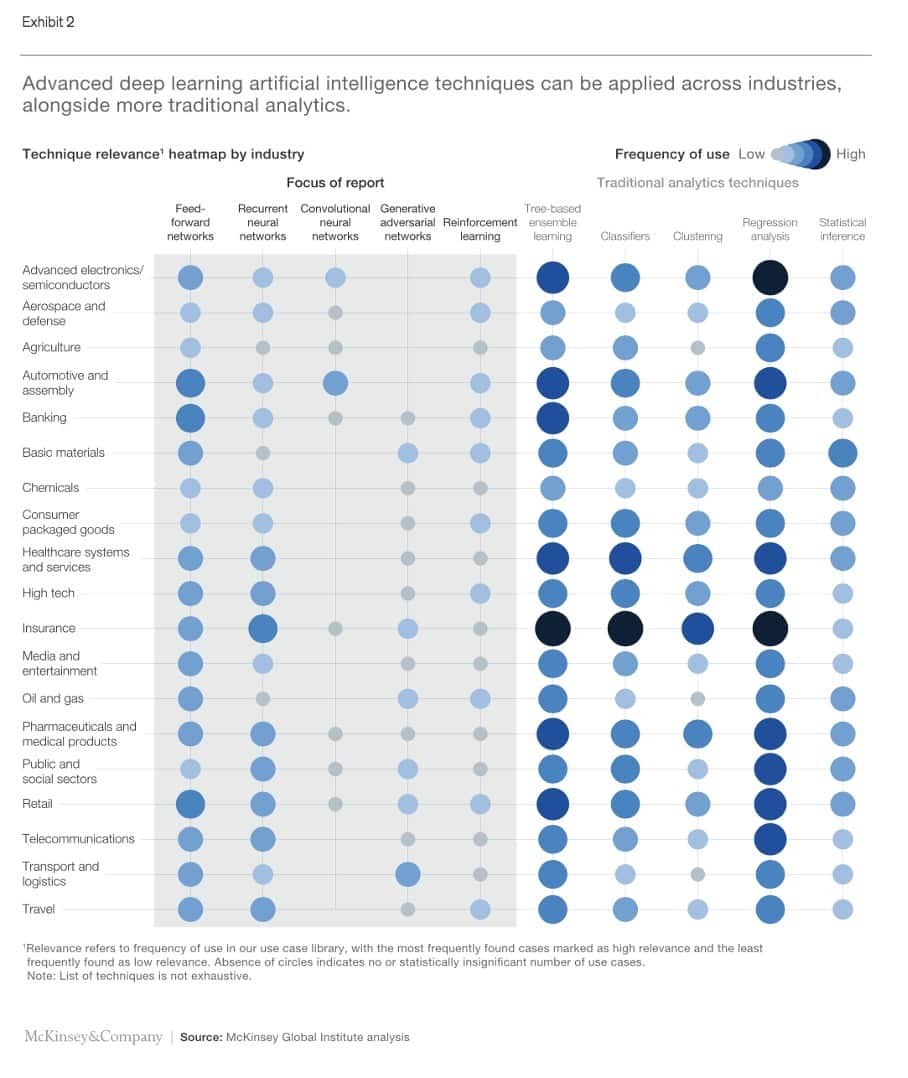Where do we stand today with Artificial Intelligence and Deep Learning in practice? And what are the short and medium-term prospects for businesses around the globe? We take a look at the impact of AI in various sectors and highlight the potential that currently remains untapped.
Global AI impact on the rise
Predictions on the economic impact of various AI technologies vary, but the general trend is unmistakably pointing up. Estimates of the projected added value of AI to the global economy range between 5 and 15 trillion USD over the next five years. For perspective, the latter figure is roughly equivalent to the entire Chinese GDP. Could it really be true that the annual economic output of the second-largest economy in the world is up for the taking? The answer to this question comes in subtle nuances.
“Forecasts indicate that the value added by AI will be equivalent to the entire annual economic output of China.”
Untapped AI potential
Past performance is not a guide to the future. Where AI is concerned, however, all indicators are pointing in the right direction for an accelerated further growth. There is still a lot of low-hanging fruit to be picked at an operational level. As consulting firm McKinsey put it in one of its reports, only about 20 percent of AI-aware companies are currently using one or more of its technologies in a core business process or at scale. This cautious approach by organizations shouldn’t come as a surprise. Affordable and easy-to-implement AI applications didn’t appear on companies’ radar until 2018 or so, which explains the reluctance for full-force innovation. As is often the case with the implementation of new technologies in a business context, the key lies in bringing sure-fire, tangible added value to the table.
Proliferation of Deep Learning algorithms
Back to the numbers. Let’s take a look at the previously mentioned McKinsey report, which details more than 400 business use case scenarios of AI across 19 different industries. One of the key exhibits of the report plots the different Deep Learning methods against their potential application in different markets. (For a detailed overview of Deep Learning and its place in the broader AI spectrum from which it branches, check out our blog on the relationship between AI, Machine Learning and Deep Learning) The overview looks like this:
What is particularly striking is the scattered presence of individual Deep Learning techniques in different sectors. Regular followers of our Trendskout updates will know that the foundations of our platform are built on finding the perfect match between the available algorithms and a particular use case or scenario. There are different algorithms for each and every application or business problem – regardless of the industry in which AI is applied. The trick is to find the most appropriate analysis method or algorithm and optimize it further for its practical purpose.
It would be unwise to jump to conclusions and mistake correlation between particular algorithms and sectors for causality. The high usage rate of different Deep Learning algorithms in the automotive sector in the graph above does not necessarily mean that this sector benefits more from specific Deep Learning techniques than others. They mostly serve as an indicator of the AI maturity of this sector. The more different applications an organization introduces, the more diverse the applied set of algorithms will be. In addition, the choice of a particular Deep Learning algorithm doesn’t tell the whole story: data transformation and hypertuning are equally crucial success factors and essential components of the Trendskout platform.
Expanding the scope
As the adoption rate of AI increases in different business units and across sectors, the number of application areas will continue to grow. There are plenty of business cases related to cost reduction and revenue and market share growth for the taking. Technical feasibility is an important aspect here. The acceptance of AI algorithms as a driver for value creation is just as important. In industries with strong first movers and inherent innovative capabilities, such as telecom and high-tech players, AI has already taken hold, whilst other sectors tend be slower to adopt. As soon as innovative players in more traditional industries dare to take the plunge, they will catch up as well. The question isn’t one of ‘if’, but of ‘when’.


